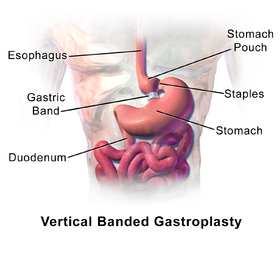This article needs additional citations for verification. (September 2018) |
| Vertical banded gastroplasty surgery | |
|---|---|
 Illustration depicting vertical banded gastroplasty | |
| Other names | Stomach stapling |
| ICD-9-CM | 44.68 |
Vertical banded gastroplasty (VBG), also known as stomach stapling, is a form of bariatric surgery for weight control. The VBG procedure involves using a band and staples to create a small stomach pouch. In the bottom of the pouch is an approximate one-centimeter hole through which the pouch contents can flow into the remainder of the stomach and hence on to the remainder of the gastrointestinal tract.
Stomach stapling is a restrictive technique for managing obesity. The pouch limits the amount of food a patient can eat at one time and slows passage of the food. Stomach stapling is more effective when combined with a malabsorptive technique, in which part of the digestive tract is bypassed, reducing the absorption of calories and nutrients. Combined restrictive and malabsorptive techniques are called gastric bypass techniques, of which Roux-en-Y gastric bypass surgery (RGB) is the most common. In this technique, staples are used to form a pouch that is connected to the small intestine, bypassing the lower stomach, the duodenum, and the first portion of the jejunum.
This type of weight loss surgery is losing favor as more doctors begin using the adjustable gastric band.[1] The newer adjustable band does not require cutting into the stomach and does not use any staple lines, thus making it a much safer alternative.
- ^ Brethauer SA, Schauer PR, Schirmer BD, eds. (2015-03-03). Minimally Invasive Bariatric Surgery. Springer. p. 273. ISBN 978-1-4939-1637-5.